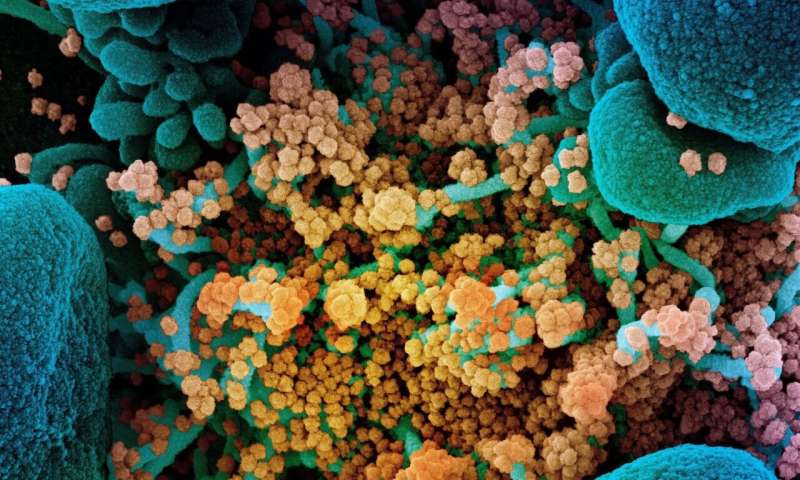
The B.1.1.7 and B.1.351 variants of SARS-CoV-2 were first detected in the UK and South Africa respectively, and have since spread to many other countries. Scientists from the Institut Pasteur joined forces with Orléans Regional Hospital, Tours University Hospital, Créteil Intercommunal Hospital, Strasbourg University Hospital and Georges Pompidou European Hospital to study the sensitivity of these two variants to neutralizing antibodies present in the serum samples of people who have been vaccinated or previously infected with SARS-CoV-2. They compared this sensitivity with that of the reference virus (D614G), which was until recently the most widespread strain in France. The scientists demonstrated that the UK variant is neutralized to the same degree as D614G, whereas the South African variant is less sensitive to neutralizing antibodies. To neutralize the South African variant, the antibody concentrations need to be six times higher than for D614G. This difference in sensitivity was also observed in vaccinated individuals; the antibodies in their serum are effective against the UK variant but less so against the South African one. The study was published in Nature Medicine on March 26th, 2021.
On December 14, 2020, the UK authorities informed WHO that a variant (B.1.1.7) had been detected in the south east of England. Within a few weeks, this variant took over from the viral strains circulating in this region and in London. On December 18, 2020, the South African authorities reported that a variant (B.1.351) had been detected and was spreading rapidly throughout three provinces of South Africa. According to WHO’s epidemiological bulletin dated February 14, the UK and South African variants are now present in 94 and 48 countries respectively. These two variants are considered to be ‘variants of interest’ and are subject to epidemiological surveillance at national and international levels.
In a new study, scientists from the Institut Pasteur joined forces with Orléans Regional Hospital, Tours University Hospital, Créteil Intercommunal Hospital, Strasbourg University Hospital and Georges Pompidou European Hospital to study the sensitivity of the UK and South African variants to antibodies in comparison with the reference strain circulating in France (D614G). The aim of this study was to characterize the capability of antibodies developed by people who had been vaccinated or previously infected with SARS-CoV-2 to neutralize these new variants.
The scientists isolated the SARS-CoV-2 variants B.1.1.7 and B.1.351 using samples provided by the National Reference Center for Respiratory Infection Viruses, hosted at the Institut Pasteur. Serum samples of people who had been vaccinated or previously exposed to SARS-CoV-2 were used to study the sensitivity of the variants to the antibodies present in this serum.
“Previously, the efficacy of neutralization had been mainly assessed using tests with pseudoviruses. We believe that it’s crucial to use authentic infectious virus strains in addition to pseudoviruses to assess viral sensitivity to neutralizing antibodies. In this study, we isolated and used authentic B.1.1.7 and B.1.351 strains and developed a novel rapid semi-automated neutralization assay based on ‘reporter’ cells that turn fluorescent after a few hours of infection,” explained Olivier Schwartz, co-last author of the study and Head of the Virus and Immunity Unit at the Institut Pasteur.
The results of the study showed that the UK variant (B.1.1.7) was neutralized by 95% (79 out of 83) of the serum of people who had been infected with SARS-CoV-2 and whose samples were taken up to nine months after the onset of symptoms. The same proportions were observed for the D614G strain, which has been the most widespread strain in France since the start of the epidemic. Moreover, there was no major difference in the antibody concentrations required to neutralize the D614G or B.1.1.7 strains.
However, the scientists noticed a decline in neutralizing activity against the South African variant in 40% of the serum samples of individuals who had been exposed to the virus, for samples taken nine months after the primary infection.
They also demonstrated that to neutralize the South African variant (B.1.351), the antibody concentrations needed to be approximately six times higher than for D614G.
“We showed that the faster-spreading variants, particularly the South African one, have become partially resistant to the antibodies produced after a natural infection. This reduced efficacy is particularly visible among individuals with low antibody levels,” commented Olivier Schwartz.
The research teams also investigated the serum samples of people who had been vaccinated with one of the first vaccines used in France (Pfizer-BioNTech COMIRNATY). The vaccinated individuals were studied two to four weeks after their first vaccine injection. The results showed that after two weeks, the serum only neutralized the D614G strain, whereas the B.1.1.7 strain started to be neutralized at week 3, although less efficiently than D614G. The anti-B.1.351 response was negative up to week 3, and could be detected at week 4.
Four weeks after the first vaccine injection (i.e. one week after the second injection), the serum samples of the vaccinated individuals were almost as effective against the UK variant as against D614G, but remained less effective against the South African variant. 80% of the serum samples were neutralizing for D614G and B.1.1.7, and 60% of the samples were neutralizing for the B.1.351 variant.
“The vaccine generated a neutralizing response that efficiently targeted the D614G and B.1.1.7 strains, despite a delay in the emergence of neutralizing antibodies against B.1.1.7. The efficacy of neutralizing antibodies for the B.1.351 strain was lower,” explained the co-last authors of the study, Sylvie van der Werf, Head of the National Reference Center for Respiratory Infection Viruses at the Institut Pasteur, and Thierry Prazuck, Head of the Infectious Diseases Department at Orléans Regional Hospital.
Source: Read Full Article
